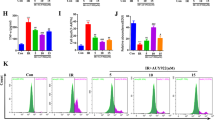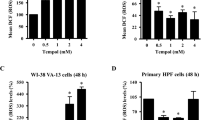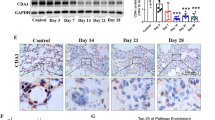Abstract
Lung cancer is the most prevalent and deadly malignancy worldwide. This study investigated the possibility of inhibiting lung cancer in vivo with adenovirus-delivered WW domain-containing oxidoreductase (wwox). The lung cancer model was established by inoculating A549 lung cancer cells into the pleural space of nude mice. The control or wwox adenovirus was injected into the pleural space 7 days after cell inoculation and 14 days after first injection. The tumor number and burdens were measured 2 weeks after second virus injection. The carcinoembryonic antigen (CEA) and alpha-feto protein (AFP) levels in pleural effusion were analyzed by enzyme-linked immunosorbent assay. Apoptosis, proliferation and angiogenesis of tumor cells were assessed by terminal deoxinucleotidyl transferase-mediated dUTP-fluorescein nick end labeling assay, proliferating cell nuclear antigen (PCNA) and CD31 staining, respectively. Ectopic wwox significantly reduced both the number and size of lung tumors accompanied by substantially lower CEA and AFP levels in pleural effusion. The expression levels of Bcl2, Bcl-xL, vascular endothelial growth factor, PCNA-positive and CD31-positive cells in the tumors were significantly decreased, whereas levels of p21 and p73 and apoptotic cells markedly increased in mice receiving the wwox virus. These data demonstrated that wwox delivered by adenovirus was able to inhibit the growth of lung cancer in vivo, indicating the potential of using wwox as a gene therapy agent for lung cancer.
This is a preview of subscription content, access via your institution
Access options
Subscribe to this journal
Receive 12 print issues and online access
$259.00 per year
only $21.58 per issue
Buy this article
- Purchase on Springer Link
- Instant access to full article PDF
Prices may be subject to local taxes which are calculated during checkout






Similar content being viewed by others
References
Torre LA, Bray F, Siegel RL, Ferlay J, Lortet-Tieulent J, Jemal A . Global cancer statistics, 2012. CA Cancer J Clin 2015; 65: 87–108.
Teng XD . [World Health Organization classification of tumours, pathology and genetics of tumours of the lung]. Zhonghua Bing Li Xue Za Zhi 2005; 34: 544–546 (in Chinese).
Bednarek AK, Laflin KJ, Daniel RL, Liao Q, Hawkins KA, Aldaz CM . WWOX, a novel WW domain-containing protein mapping to human chromosome 16q23.3-24.1, a region frequently affected in breast cancer. Cancer Res 2000; 60: 2140–2145.
Bednarek AK, Keck-Waggoner CL, Daniel RL, Laflin KJ, Bergsagel PL, Kiguchi K et al. WWOX, the FRA16D gene, behaves as a suppressor of tumor growth. Cancer Res 2001; 61: 8068–8073.
Lewandowska U, Zelazowski M, Seta K, Byczewska M, Pluciennik E, Bednarek AK . WWOX, the tumour suppressor gene affected in multiple cancers. J Physiol Pharmacol 2009; 60 (Suppl 1): 47–56.
Donati V, Fontanini G, Dell'Omodarme M, Prati MC, Nuti S, Lucchi M et al. WWOX expression in different histologic types and subtypes of non-small cell lung cancer. Clin Cancer Res 2007; 13: 884–891.
Baykara O, Demirkaya A, Kaynak K, Tanju S, Toker A, Buyru N . WWOX gene may contribute to progression of non-small-cell lung cancer (NSCLC). Tumour Biol 2010; 31: 315–320.
Yang L, Liu B, Huang B, Deng J, Li H, Yu B et al. A functional copy number variation in the WWOX gene is associated with lung cancer risk in Chinese. Hum Mol Genet 2013; 22: 1886–1894.
Bleau AM, Freire J, Pajares MJ, Zudaire I, Anton I, Nistal-Villán E et al. New syngeneic inflammatory-related lung cancer metastatic model harboring double KRAS/WWOX alterations. Int J Cancer 2014; 135: 2516–2527.
Becker S, Markova B, Wiewrodt R, Hoffarth S, Hähnel PS, Pleiner S et al. Functional and clinical characterization of the putative tumor suppressor WWOX in non-small cell lung cancer. J Thorac Oncol 2011; 6: 1976–1983.
Zhang P, Jia R, Ying L, Liu B, Qian G, Fan X et al. WWOX-mediated apoptosis in A549 cells mainly involves the mitochondrial pathway. Mol Med Rep 2012; 6: 121–124.
Kimura M, Takenobu H, Akita N, Nakazawa A, Ochiai H, Shimozato O et al. Bmi1 regulates cell fate via tumor suppressor WWOX repression in small-cell lung cancer cells. Cancer Sci 2011; 102: 983–990.
Lin JT, Li HY, Chang NS, Lin CH, Chen YC, Lu PJ . WWOX suppresses prostate cancer cell progression through cyclin D1-mediated cell cycle arrest in the G1 phase. Cell Cycle 2015; 14: 408–416.
Gourley C, Paige AJ, Taylor KJ, Ward C, Kuske B, Zhang J et al. WWOX gene expression abolishes ovarian cancer tumorigenicity in vivo and decreases attachment to fibronectin via integrin alpha3. Cancer Res 2009; 69: 4835–4842.
Yan HC, Xu J, Fang LS, Qiu YY, Lin XM, Huang HX et al. Ectopic expression of the WWOX gene suppresses stemness of human ovarian cancer stem cells. Oncol Lett 2015; 9: 1614–1620.
Amelio I, Inoue S, Markert EK, Levine AJ, Knight RA, Mak TW et al. TAp73 opposes tumor angiogenesis by promoting hypoxia-inducible factor 1α degradation. Proc Natl Acad Sci USA 2015; 112: 226–231.
Stantic M, Sakil HA, Zirath H, Fang T, Sanz G, Fernandez-Woodbridge A et al. TAp73 suppresses tumor angiogenesis through repression of proangiogenic cytokines and HIF-1α activity. Proc Natl Acad Sci USA 2015; 112: 220–225.
Harris AL . Hypoxia—a key regulatory factor in tumour growth. Nat Rev Cancer 2002; 2: 38–47.
Acknowledgements
This study was supported by the 11th Annual ‘Six Talent Summit’ Grants of Jiangsu province (2014-WSW-064) and Wuxi Municipal Health Bureau General Grants (ML201209).
Author information
Authors and Affiliations
Corresponding author
Ethics declarations
Competing interests
The authors declare no conflict of interest.
Rights and permissions
About this article
Cite this article
Zhou, Y., Shou, F., Zhang, H. et al. Adenovirus-delivered wwox inhibited lung cancer growth in vivo in a mouse model. Cancer Gene Ther 23, 1–6 (2016). https://doi.org/10.1038/cgt.2015.56
Received:
Revised:
Accepted:
Published:
Issue Date:
DOI: https://doi.org/10.1038/cgt.2015.56
This article is cited by
-
Characterization of WWOX expression and function in canine mast cell tumors and malignant mast cell lines
BMC Veterinary Research (2020)
-
WWOX inhibits the invasion of lung cancer cells by downregulating RUNX2
Cancer Gene Therapy (2016)



